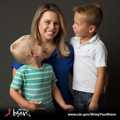Amy’s Story

Cancer runs in Amy’s family: her grandmother had both breast and ovarian cancer, and encouraged her family to learn about their risk.
As a result, Amy’s father and two of his sisters decided to get genetic testingTests that involve analyzing DNA, the chemical database that carries instructions for your body’s functions, to look for a genetic change that may show a higher risk of getting a disease. for BRCA gene mutations.BRCA stands for BReast CAncer gene. Any changes, called “mutations,” in these two genes (BRCA1 and BRCA2) can raise breast cancer risk. Although her aunts tested negative, Amy’s father found out he was positive for a BRCA2 gene mutation, meaning Amy had a 50% chance of carrying the gene mutation.
At 31, after having two children and moving back to California to live near her friends and loved ones, Amy herself finally felt ready to see a genetic counselor, who recommended testing for BRCA gene mutations.
Because Amy is of Ashkenazi Jewish descent,Jewish people from France, Germany, or Eastern Europe and their descendants her genetic counselor recommended that she get tested for BRCA gene mutations, which are common in people with this ancestry. The genetic testing revealed she has a BRCA2 gene mutation.
To manage her risk for developing breast cancer, Amy gets regular screenings. She considers knowing her breast cancer risk a “head start” in staying vigilant with regard to prevention—truly empowered by learning her risk.
Amy lives in California with her husband and two young sons, and works as a nurse practitioner at a pediatric office. She enjoys playing tennis and spending time with her family.
Share Amy’s Story on Social Media

Amy had a 50% chance of carrying a BRCA gene mutation because her father is a carrier. She decided to get genetic counseling and testing for the three BRCA mutations common in Ashkenazi Jewish women. Read her story and learn why Jewish women are at higher risk for a BRCA gene mutation. http://1.usa.gov/1Qp4lcf
- Page last reviewed: January 13, 2016
- Page last updated: January 13, 2016
- Content source:



 ShareCompartir
ShareCompartir
